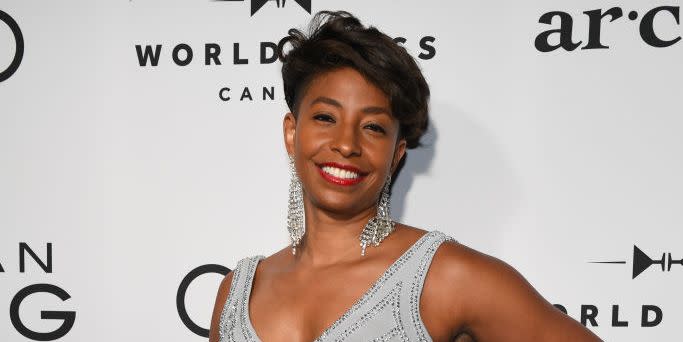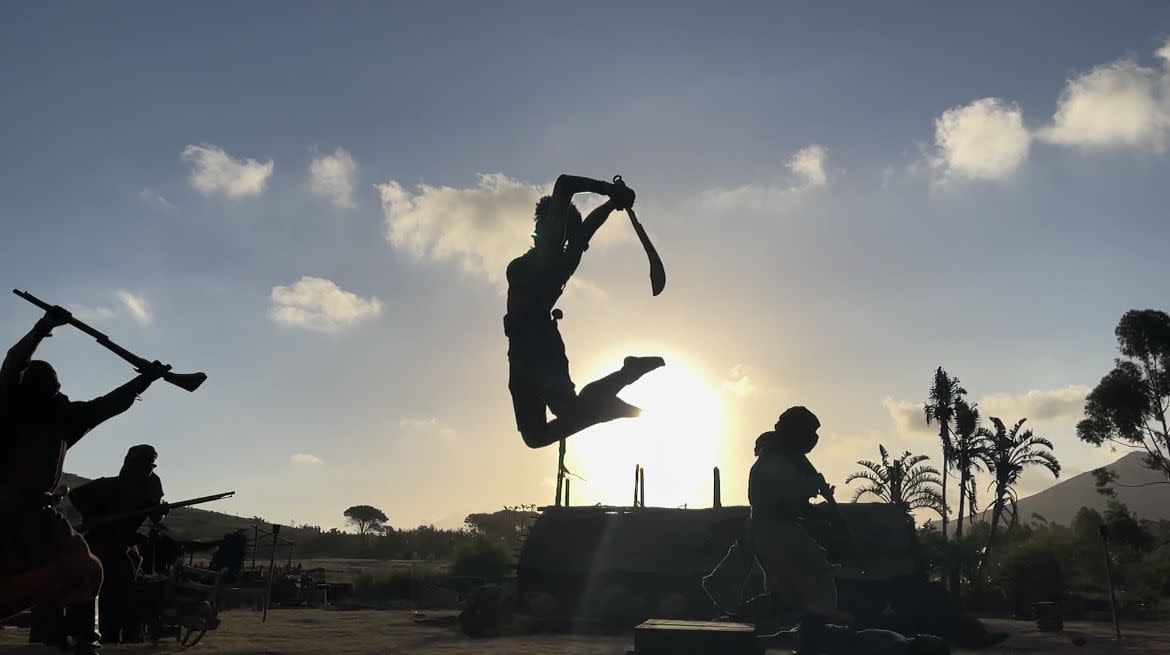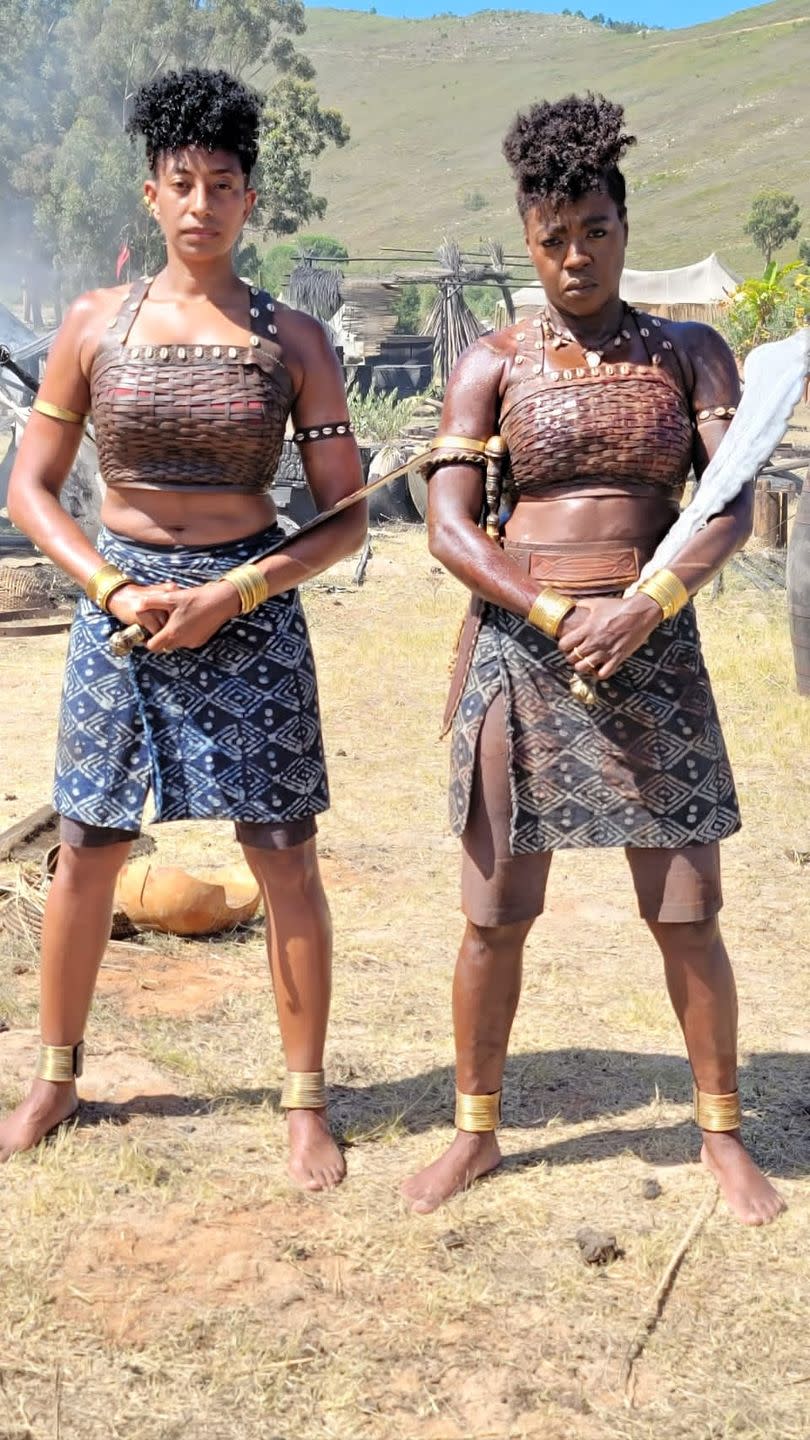Without Jénel Stevens, ‘The Woman King’ Fight Scenes Wouldn't Exist

You might not know Jénel Stevens' name, but you've definitely seen her on-screen before. And that's because Jénel is the face (well, body) behind the some of wildest stunts in Black Panther, Avengers: Infinity War, Avengers: Endgame, Joker, The Falcon and the Winter Soldier, Free Guy, Billions, and Ms. Marvel, just to name a few.
Now, Jénel has taken on one of her most intense roles to date as Viola Davis’ stunt double in the new film, The Woman King, directed by Gina Prince-Bythewood. The Woman King tells the true story of the Agojie, an all-female group of warriors who defended the West African kingdom of Dahomey in the 1820s. Viola (and Jénel) play the group's badass, iconic leader, Nanisca. And they're not messing around.
“This was a story that has never been told before on camera,” Jénel says.
Ahead, read all about Jénel’s stunt background, how she helped train and condition the cast, and the essential lessons she learned on set.
She's got a pretty unusual (and active) resume.
“I've been training for this career my entire life,” Jénel says. And if you look at her resumé, it certainly looks that way.
For one, she always played sports growing up, and her father was a New York police officer, so she'd done gun training with him. Plus, Jénel she has a black belt in martial arts. But it doesn't stop there.
Out in the real world, Jénel started out modeling and acting before becoming a personal trainer at Equinox. She then started training in martial arts at Anderson's Martial Arts Academy in New York City, becoming such a regular that she struck up a friendship with the owners and even started helping out with classes. Eventually, she launched her own martial arts-based personal training business, housed under the academy's roof.
And this unusual resume helped set Jénel apart.
“After the first [stuntwoman] job, somebody else wanted to hire me right away,” she explains. It helped that the superhero film industry had started introducing more diversity into its casts and films, providing more opportunities for Jénel to fill in as a stunt double.
“A lot of Black women are now becoming superheroes or action heroes, so it just worked out,” she explains.
And while stunt fighting is her main "forte," Jénel is proficient in all kinds of stunts. In fact, she usually tries to learn a bit of everything to get hired for more jobs—doing driving courses, taking horseback riding lessons, or even tactical training course work.
"I have to keep doing them to stay sharp—if you don’t use it, you lose it!"
The whole 'Woman King' cast went through intense training.
"Fight easy, train hard." That was the motto the cast lived by during the grueling shoot. They'd train for eight to nine hours at a time to prep for even longer shoot days, which were usually 10 to 12 hours long.
With the help of stunt coordinator Danny Hernandez, Jénel helped the entire cast learn basic weapon strikes, and then choreographed the stunts for them to practice. It started by breaking down the steps and having the cast memorize each move.
The two taught the cast a numerical strike system using the Kali style, an ancient Filipino fighting method. Basic moves are assigned numbers one through five, or one through 12—meaning that each motion had a number, like a kick, stab, or punch. After teaching the basic moves, they'd create combos and add on from there to make the moves more complex.
This fighting style directly applied to the film. Take the first scene, for example—the Agojie rise up out of the bushes and fight a group of men.
After the cast learned their combos, Jénel would have them practice with other stuntpeople before practicing with each other.
“At first, it would blow their minds [because it seemed overwhelming], but then they got into a rhythm with it and they just got used to it,” she says. “It was a team effort for sure.”
Jénel and the cast focused on cardio and strength training.
For her role in The Woman King, Jénel followed a lifting program to help her build muscle mass which included single joint lifts, like bicep curls and tricep exercises "to get a little bigger," she says. "I’m a naturally thin person so I didn’t do as much cardio as just plain old weightlifting."
The goal was to get those rippling muscles super visible.
The cast also had to do lots of cardio training, which makes sense, given there was a lot of running going on in the movie.

And while this all sounds complicated, Jénel explains that it's really all about basics when it comes to fitness and learning stunts. "Once you have the building blocks, then you can build mountains and buildings and cities and communities—so that's basically what we did."
Jénel is breaking all kinds of barriers.
When she arrived in South Africa to train, a lot of the core training team members were men, while the cast was mostly women.
“When I stepped on the mat for the first time, the women—I could just feel the respect that they gave and to feel that, ‘Wow, this is a woman, not only a woman, but a woman of color who's leading this class, not just taking it with us—I felt the respect,” Jénel explains.
There has been a recent shift in onscreen representation in the Marvel Cinematic Universe. But in the stunt world, it's still pretty homogenous. “There's not enough women in that field, let alone Black women,” Jénel explains.
Jénel is grateful for the mentors who lifted her up, and she's determined to show women of color and Black women that they belong in these films.

“It's important for every woman to know and every Black female to know that this is a route you can take," she says.
You Might Also Like
